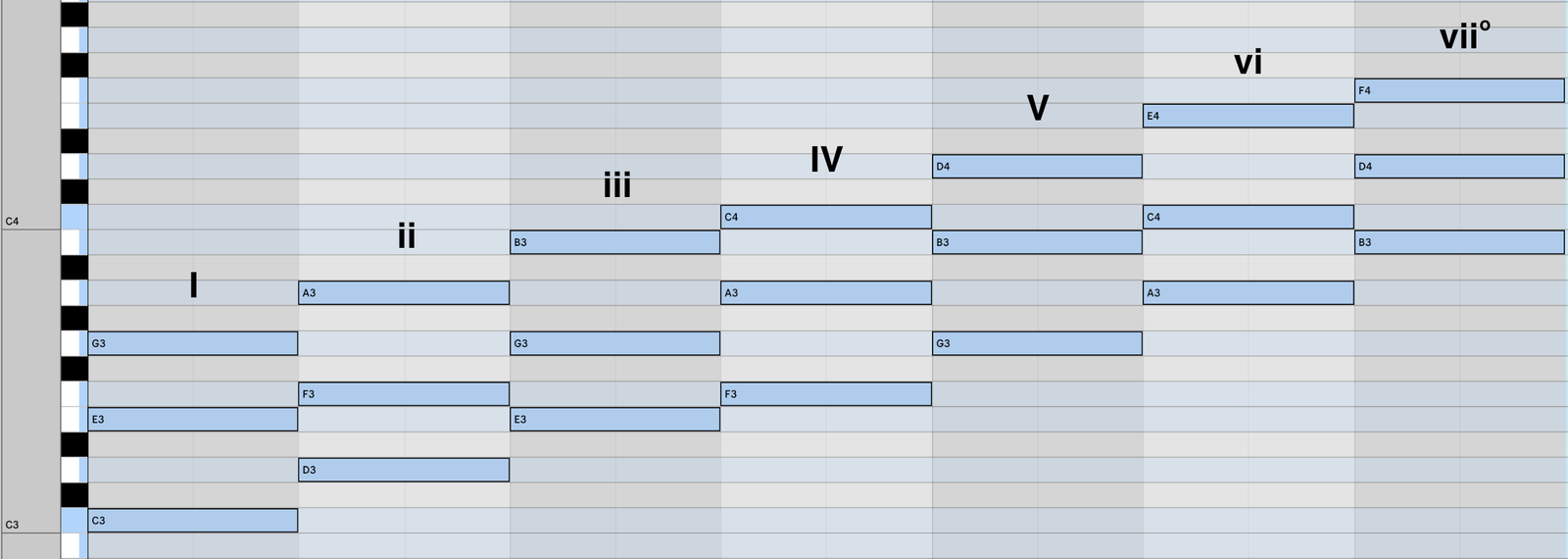These 5 chord progressions can be used in ANY genre of modern music – from house, techno and trance, to trap, drum & bass and even pop music!
I’ll also share with you a few examples of which tracks they’re already used in – PLUS how to customise them to make them your own.
In this blog post, I’m going to share with you the 5 chord progressions that every music producer NEEDS to know…
Firstly, we’ll have a quick look at the Roman numeral system of writing chords, as it’s essential for understanding these 5 chord progressions…
Roman Numerals for Chords
The Roman numeral system for representing chords in a key is particularly useful for quickly sharing chord progressions with other musicians.
It’s a relative system, meaning – as long as you know which key you’re working in – you can quickly work out the notes of a chord at a glance, based on the Roman numeral representing it.
In the Roman numeral system, chords are numbered from 1 to 7 – representing each note in a standard scale – and the chords subsequently built from each of those notes as the chord’s root.
In Roman numerals, 1 to 7 looks like this: I, II, III, IV, V, VI, VII (“V” representing “5”), or – in lower case – i, ii, iii, iv, v, vi, vii.
Whether you use upper case or lower case depends on whether the chord is major (upper case) or minor (lower case).
For example, the key of C Major has 7 notes: C, D, E, F, G, A, B, so the standard, 3 note “triad” chords in the key of C Major (using only notes from with that key) would be I, ii, iii, IV, V, vi, viio (the little “o” representing a diminished chord).

If you see a little number next to a chord (like a 7), it means the seventh note above the root of the chord has been added – but more on that later!
A sus4 or sus2 means a “suspended” chord, but we’ll cover that later in this post, too.
With that in mind, here are the 5 essential chord progressions you should know, with examples of tracks in which they’ve been used:
1. “The Optimist” – i VI III VII
Looks Like:

Sounds Like:
Used in Avicii – “Wake Me Up” (in the key of B Minor):
2. “The E P I C !!!” – iv VI v VII
Looks Like:

Sounds Like:
Used in the chorus of Swedish House Mafia – “One” (in the key of D Minor):
3. “The Smooth Descender” – im7 VII VImaj7 ivm7
The “m7” signifies that a minor 7th note has been added to the chord, which is 3 semitones above the top note of the 3-note chord (triad).
The “maj7” signifies that a major 7th note has been added to the chord, which is 4 semitones above the top note of the 3-note chord (triad).
Looks Like:

Sounds Like:
Used in Duke Dumont – “Ocean Drive” (in the key of G# Minor):
4. “The Heart Melter” – VImaj7 VII i III
The “maj7” signifies that a major 7th note has been added to the chord, which is 4 semitones above the top note of the 3-note chord (triad).
Looks Like:

Sounds Like:
Used in Major Lazer & DJ Snake – “Lean On featuring MØ” (in the key of G Minor):
5. “The Emotional” – VI VII v i
Looks Like:

Sounds Like:
Used in David Guetta & Sia – “Titanium” (in the key of C Minor):
BONUS: How to Make These Chords Your Own
There are a few ways we can switch these chord progressions up a bit and make them unique to our tracks. Check out this video for examples.
1. Extended Chords
You can add the seventh, ninth or eleventh note above the root note of a chord to add a different quality to it.
2. Chord Inversions
This is where you simply change the order of the notes in a chord (e.g. the lowest note in the chord could be moved up an octave, thus making it the highest note in that triad, even though the same notes are being used).
3. Suspended Chords
The is where you move the middle note of your triad (the “3rd”), up to the fourth interval in the chord OR down to the 2nd interval of the chord. This gives added suspense that ultimately seeks resolution, either by moving the suspended note back to the 3rd interval, or by moving onto the next chord.
I hope you’ve found this useful! If you want more information on music theory for dance music production, check out my Music Theory for EDM Producers course here. It’s helped thousands of new producers get their music finished, released and – in many cases – signed to record labels.
Which is your favourite chord progression? Let me know in the comments below!
